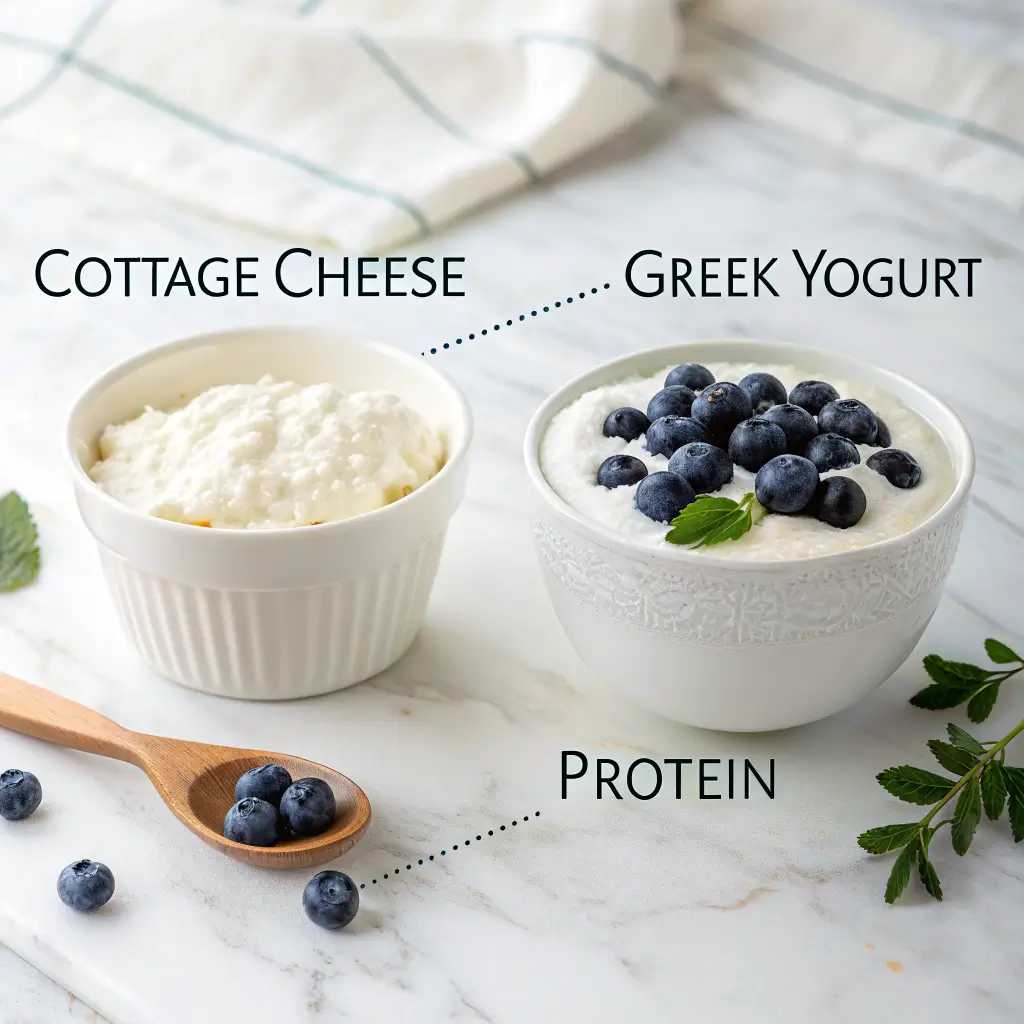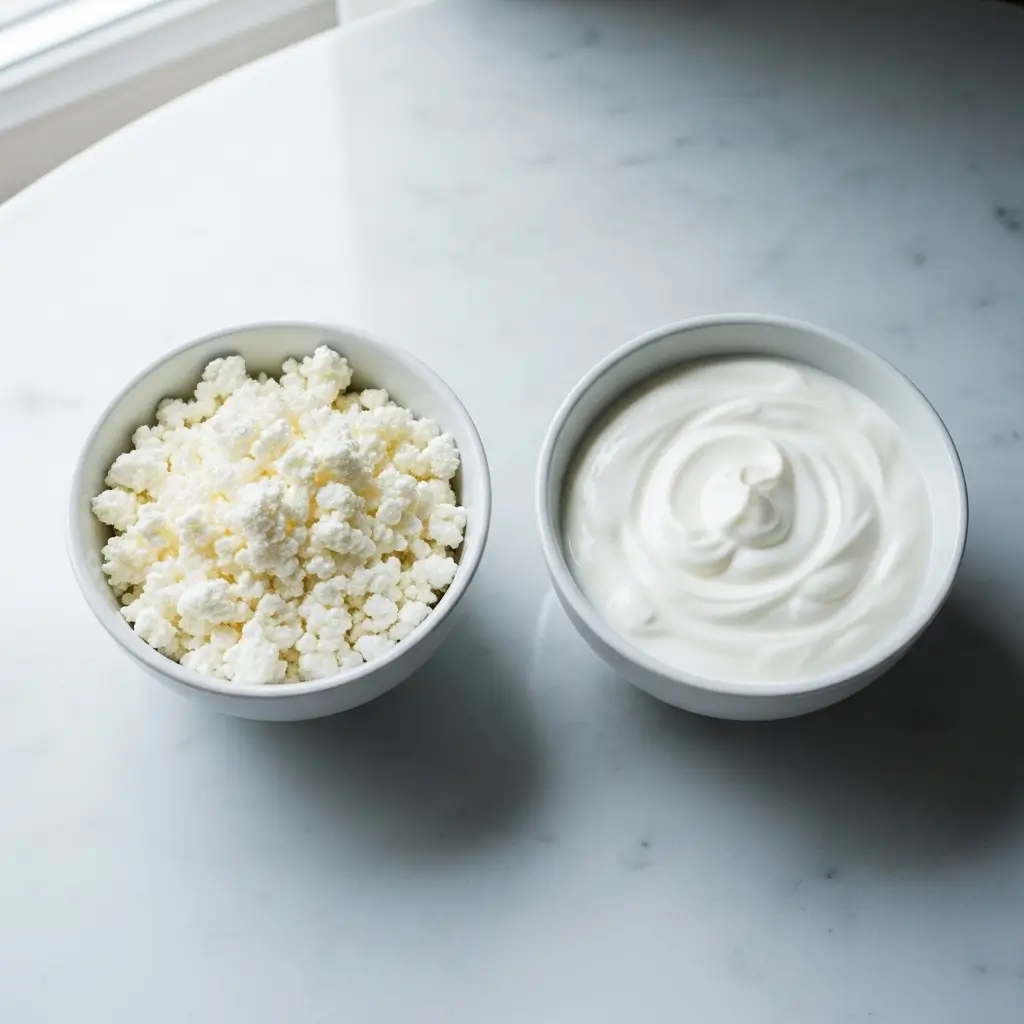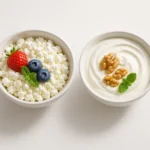
In the hallowed halls of fitness nutrition, two dairy titans constantly vie for the top spot in the shopping carts of athletes, bodybuilders, and health-conscious individuals alike: cottage cheese and Greek yogurt. This isn’t just a casual rivalry; it’s a full-blown debate fueled by discussions in online forums, gym locker rooms, and meal-prep Sunday kitchens. The core of this clash comes down to one critical question: which one is truly better for hitting your macros?
For anyone serious about tracking their nutrition, understanding the subtle yet significant differences between these protein powerhouses is crucial. This comparison goes beyond a simple glance at the protein number on the label. It’s about the quality of that protein, the accompanying carbs and fats, the cost per gram, and how each fits into specific fitness goals.
In this definitive 2025 guide, we will dissect every facet of the cottage cheese vs Greek yogurt macros debate. We’ll put them head-to-head on protein content, calorie density, taste, versatility, and cost, providing you with the data-driven insights you need to declare a personal winner for your specific goals, whether that’s shedding fat, building muscle, or simply maintaining a healthy lifestyle.
Table of Contents
Table of Contents
Head-to-Head Macro Comparison: The Nitty-Gritty Numbers
At first glance, cottage cheese and Greek yogurt seem nutritionally similar. Both are celebrated for their high protein content. However, a closer look at the data reveals key distinctions that can influence your dietary choices. To provide the clearest comparison, we’ll analyze them per 100 grams (for a direct scientific comparison) and per a common serving size of one cup (226g).
For this analysis, we are using typical 2% milkfat versions of both products, as they represent a popular middle-ground choice.
Macro Breakdown per 100g (Approximate Values)
| Nutrient | Low-Fat (2%) Cottage Cheese | Plain Low-Fat (2%) Greek Yogurt |
|---|---|---|
| Calories | 81 kcal | 73 kcal |
| Protein | 12.4 g | 10 g |
| Carbohydrates | 4.1 g | 3.9 g |
| Fat | 2.3 g | 2 g |
| Sodium | 321 mg | 36 mg |
Macro Breakdown per 1 Cup (226g) Serving (Approximate Values)
| Nutrient | Low-Fat (2%) Cottage Cheese | Plain Low-Fat (2%) Greek Yogurt |
|---|---|---|
| Calories | 183 kcal | 165 kcal |
| Protein | 28 g | 22.6 g |
| Carbohydrates | 9.3 g | 8.8 g |
| Fat | 5.2 g | 4.5 g |
| Sodium | 725 mg | 81 mg |

The distinct advantage of cottage cheese for satiety and overnight muscle repair comes from its protein composition. A significant portion of its protein is casein, which digests slowly. According to dietitians at the Cleveland Clinic, this property allows for a prolonged release of amino acids, aiding recovery and reducing muscle breakdown during sleep.
Protein Power: Quantity, Quality, and Amino Acids
The most sought-after metric in the cottage cheese vs greek yogurt protein showdown is, of course, the protein content itself.
- Quantity: As the tables clearly show, cottage cheese consistently packs more protein per serving. A one-cup serving can have a significant 5-6 gram advantage over its Greek yogurt counterpart. For individuals with high protein targets, this difference can add up quickly over a day. A deep dive into the specifics of Cottage Cheese Macros reveals just how protein-dense this simple food can be.
- Quality & Type: The type of protein is just as important as the amount. Both are complete proteins, meaning they contain all nine essential amino acids necessary for muscle repair and growth. The primary difference lies in the ratio of casein to whey protein.
- Cottage Cheese is roughly 80% casein protein. Casein is a slow-digesting protein, forming a gel-like substance in the stomach. This leads to a steady, prolonged release of amino acids into the bloodstream, making it an excellent choice for sustained satiety and for preventing muscle breakdown, especially when consumed before bed.
- Greek Yogurt has a more balanced blend of casein and whey protein. The whey is fast-digesting, making it ideal for post-workout recovery when your muscles are primed for rapid amino acid absorption.
Calorie, Carbohydrate, and Fat Analysis
- Calorie Density: Greek yogurt typically has a slight edge, being slightly lower in calories per serving. However, the difference is minimal and the higher protein in cottage cheese may offer a better “protein-to-calorie” ratio for many.
- Carbohydrate Content: Both are relatively low in carbohydrates, with the sugars coming naturally from lactose. The real danger lies in flavored Greek yogurts, which can be loaded with added sugars, often packing 10-15 grams or more of sugar per serving and undermining your health goals. Plain cottage cheese and plain Greek yogurt are always the superior choices.
- Fat Content: Both products are available in a range of fat percentages, from non-fat (0%) to low-fat (2%) and full-fat (4-5%+). The fat content impacts creaminess, flavor, and the absorption of fat-soluble vitamins, but it also increases the calorie count.
- Sodium: This is a critical and often-overlooked differentiator. Cottage cheese is significantly higher in sodium, which is added during production for flavor and preservation. A single cup can contain over 30% of the recommended daily intake. For individuals monitoring their blood pressure or sodium intake, Greek yogurt is the undisputed winner in this regard.
Taste, Texture & Versatility: Beyond the Spoon
Macros aren’t everything; for a food to become a staple, it has to be enjoyable and adaptable. Here, the two dairy products offer vastly different sensory experiences.
- Taste and Texture:
- Cottage Cheese: Known for its lumpy, curd-like texture (available in small or large curd) suspended in a creamy dressing. Its flavor is mild, milky, and distinctly salty. Whipped cottage cheese is a growing trend, offering a smoother texture for those who dislike the curds.
- Greek Yogurt: Prized for its thick, smooth, and creamy consistency, a result of straining out excess whey. Its flavor profile is characteristically tangy and slightly sour, which can be a refreshing counterpoint in many dishes.
- Cooking and Baking Applications:
- Greek Yogurt is a culinary chameleon. It’s an incredible substitute for sour cream or mayonnaise in dips and dressings, adds moisture and a protein boost to baked goods like muffins and cakes, and serves as a tenderizing agent in marinades for meat.
- Cottage Cheese also has its place in the kitchen. It can be blended into a smooth, protein-rich base for creamy pasta sauces or dips. It’s famously used to add protein and moisture to pancakes, scrambled eggs, and even lasagna, where it can be a healthier alternative in the great Cottage Cheese vs Ricotta debate.
- Mix-in Compatibility: Both are excellent vehicles for other flavors. Greek yogurt’s tanginess pairs exceptionally well with sweet additions like fruit, honey, granola, and protein powder. Cottage cheese, with its savory, salty base, shines with savory mix-ins like black pepper, chives, tomatoes, and avocado, though it also pairs nicely with fruit for a sweet-and-salty combination.

Cost Analysis: The Price of Protein
For those who consume high-protein dairy daily, the cost can add up. We analyzed the price per gram of protein to determine which option offers more bang for your buck.
On average, cottage cheese is the more budget-friendly option when measured by the price per gram of protein.
Let’s break it down with a typical example:
- A 32-ounce (907g) tub of store-brand 2% cottage cheese might cost $4.50 and contain approximately 112g of protein.
- Cost per gram of protein: ~$0.040
- A 32-ounce (907g) tub of store-brand 2% plain Greek yogurt might cost $4.75 and contain approximately 90g of protein.
- Cost per gram of protein: ~$0.053
While prices fluctuate based on brand, location, and sales, this trend generally holds true. Premium brands like Good Culture (for cottage cheese) or Fage (for Greek yogurt) will be more expensive, but the underlying value proposition often remains. Buying larger tubs is almost always more economical than purchasing single-serving cups. For the budget-conscious athlete looking to maximize protein intake without breaking the bank, cottage cheese is typically the smarter financial choice.
Specific Use Case Recommendations: Which is Right for You?
The “better” choice truly depends on your specific, individual goals. Let’s place these two foods in a High Protein Foods Showdown and see which one comes out on top for different scenarios.
For Maximum Weight Loss
When the goal is fat loss, the key factors are satiety (feeling full) and maximizing protein per calorie.
- Cottage Cheese takes the lead here. Its high concentration of slow-digesting casein protein promotes fullness for a longer period, helping to crush cravings and reduce overall calorie intake. The slight edge in total protein per serving also contributes to a higher thermic effect of food, meaning your body burns more calories just digesting it.
- Recommendation: Prioritize low-fat or non-fat cottage cheese as a primary protein source in a calorie-controlled diet.
For Building Lean Muscle
For muscle hypertrophy, you need ample protein to fuel muscle protein synthesis (MPS), especially around your workouts and throughout the day.
- It’s a strategic tie.
- Post-Workout: Greek yogurt’s blend of fast-acting whey and slow-acting casein makes it an excellent choice for a post-workout meal to kickstart the recovery process quickly.
- Before Bed: Cottage cheese is the undisputed king of pre-sleep nutrition. Its slow-release casein protein provides a steady stream of amino acids to your muscles overnight, preventing catabolism (muscle breakdown) while you sleep.
- Recommendation: Use both strategically. Greek yogurt within 1-2 hours after a workout, and cottage cheese as your final meal of the day.
For General Health & Wellness
Looking beyond just macros, we need to consider micronutrients and other health benefits.
- Greek Yogurt has a distinct advantage here due to one key component: probiotics. The live and active cultures in Greek yogurt are fantastic for promoting a healthy gut microbiome, which is linked to improved digestion, a stronger immune system, and even better mental health. It’s also typically a better source of calcium.
- Cottage Cheese’s main drawback in this category is its high sodium content, which can be a concern for those with hypertension or anyone advised to follow a low-sodium diet.
- Recommendation: For daily digestive health and a gut-friendly boost, Greek yogurt is the superior choice.
For Digestive Considerations
For individuals with sensitive stomachs or mild lactose intolerance, the choice can be nuanced.
- Both products contain lactose. However, the straining process for Greek yogurt removes some of the whey and lactose. Furthermore, the live bacterial cultures in yogurt help break down the lactose, making it easier for many people to digest compared to other dairy products.
- Recommendation: If you struggle with dairy, start with a small amount of plain Greek yogurt to see how you tolerate it. Its probiotic content may offer digestive benefits that cottage cheese lacks.
The Final Verdict: Winner by Category (2025)
After a thorough, data-driven showdown, it’s clear that both cottage cheese and Greek yogurt are nutritional champions. There is no single “loser” here, but by breaking it down by specific goals, we can crown a winner in each category.
- 🏆 Best for Maximum Protein Punch:Cottage Cheese
- With a consistent 25-28 grams of protein per cup, it simply packs more muscle-building fuel per serving.
- 🏆 Best for Weight Loss & Satiety:Cottage Cheese
- The dominance of slow-digesting casein protein is a game-changer for appetite control and staying full between meals, making it a dieter’s best friend.
- 🏆 Best for Gut Health & Digestion:Greek Yogurt
- The undeniable benefit of live and active probiotic cultures gives it a massive edge for promoting a healthy gut microbiome and improving digestion.
- 🏆 Best for Culinary Versatility:Greek Yogurt
- Its smooth texture and tangy flavor make it more adaptable as a seamless substitute in a wider range of recipes, from dips and sauces to baked goods.
- 🏆 Best for the Budget-Conscious:Cottage Cheese
- It consistently offers a lower price per gram of protein, making it the more economical choice for hitting high protein targets day after day.
Overall Recommendation
So, who is the ultimate champion in the 2025 macro showdown? The winner is the one that best aligns with your primary goal.
If your top priority is maximizing protein intake for muscle growth or enhancing satiety for fat loss on a tight budget, cottage cheese is your champion.
If you are focused on overall wellness, digestive health, culinary flexibility, and need a lower-sodium option, Greek yogurt takes the crown.
Ultimately, the smartest approach is to recognize the unique strengths of each. The true winner is the informed individual who doesn’t choose one over the other, but incorporates both strategically into a well-rounded nutrition plan—leveraging Greek
Want more healthy recipe inspiration and nutrition tips? Follow us on Facebook for daily meal ideas, expert advice, and delicious ways to incorporate both cottage cheese and Greek yogurt into your healthy lifestyle!
Frequently Asked Questions
Is cottage cheese better for you than Greek yogurt?
Neither cottage cheese nor Greek yogurt is definitively “better” – both are excellent high-protein dairy options with unique advantages. Cottage cheese contains slightly more protein per serving (about 12g vs 10g per half-cup) and higher calcium content, making it ideal for muscle building and bone health.
However, Greek yogurt offers superior probiotic benefits for digestive health and contains virtually no sodium compared to cottage cheese’s 350mg per serving. The best choice depends on your specific health goals, sodium sensitivity, and taste preferences. If you’re focused on maximizing protein intake and don’t have blood pressure concerns, cottage cheese edges ahead. For digestive health and lower sodium intake, Greek yogurt is the winner.
Why do gym people eat cottage cheese?
Fitness enthusiasts gravitate toward cottage cheese for several strategic reasons. First, it’s packed with casein protein, which digests slowly and provides a steady release of amino acids over 6-8 hours – perfect for overnight muscle recovery when eaten before bed. With about 28 grams of protein per cup, it’s one of the most protein-dense foods available.
Cottage cheese is also relatively low in calories and carbs, making it ideal for both cutting (fat loss) and bulking (muscle gain) phases. The high sodium content can actually benefit athletes who lose significant electrolytes through sweat. Additionally, it’s affordable, convenient, and requires no preparation – you can eat it straight from the container post-workout for immediate protein delivery to muscles.
Is it OK to eat cottage cheese every day?
Yes, eating cottage cheese daily can be perfectly healthy for most people and may even provide significant nutritional benefits. With its high protein content (about 25% of daily needs per cup), calcium for bone health, and B vitamins for energy metabolism, daily cottage cheese consumption supports muscle maintenance, bone density, and overall nutrition.
However, there are a few considerations: the high sodium content (700mg per cup) may be problematic for those with high blood pressure or heart conditions. If you eat a lot of processed foods, daily cottage cheese could push your sodium intake too high. To enjoy cottage cheese safely every day, choose low-sodium varieties when possible, balance it with plenty of fresh fruits and vegetables, and monitor your overall sodium intake from other sources.
Is cottage cheese for bulking or cutting?
Cottage cheese is actually excellent for both bulking and cutting phases, which makes it a staple in many bodybuilders’ diets year-round. For cutting (fat loss), cottage cheese shines because it’s high in protein but relatively low in calories – helping preserve muscle mass while in a caloric deficit. The casein protein promotes satiety, reducing cravings and helping you stick to your calorie goals.
For bulking (muscle gain), cottage cheese provides the high-quality protein needed for muscle synthesis, and you can easily increase calories by choosing full-fat versions or adding calorie-dense toppings like nuts, fruit, or honey. The slow-digesting casein is particularly valuable during bulking when eaten before bed, as it supplies amino acids throughout the night when muscle growth and recovery occur. Many athletes use it strategically – low-fat versions for cutting phases and full-fat versions for bulking.

Cottage Cheese vs Greek Yogurt
- Total Time: 5 minutes
- Yield: 1 serving
Description
A detailed comparison between cottage cheese and Greek yogurt – both packed with protein but differing in sodium, digestion, taste, and ideal usage based on your health goals.
Ingredients
- 1 cup low-fat cottage cheese
- 1 cup low-fat Greek yogurt
- Optional toppings: fruit, honey, herbs, nuts
- For comparison: nutrition facts labels of both products
Instructions
- Compare nutritional labels of each: check calories, protein, sodium, fat, and calcium.
- Evaluate protein type and digestion: cottage cheese is casein-heavy (slow digesting), Greek yogurt is quicker digesting.
- Identify dietary needs: for low sodium, choose Greek yogurt; for overnight recovery, choose cottage cheese.
- Match with your goals: Greek yogurt for gut health and post-workout, cottage cheese for long satiety and muscle repair.
- Consider texture and flavor preferences: Greek yogurt is smooth and tangy, cottage cheese is chunky and mild.
- Try combining both for different times of day – yogurt in the morning, cottage cheese at night.
Notes
Cottage cheese contains about 8x more sodium than Greek yogurt. Choose based on your health goals, taste preferences, and timing needs (quick vs. sustained protein delivery).
- Prep Time: 5 minutes
- Cook Time: 0 minutes
- Category: Nutrition Comparison
- Method: No Cook
- Cuisine: Health & Fitness
